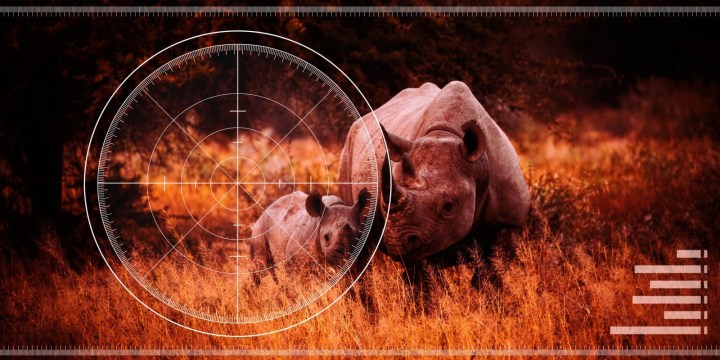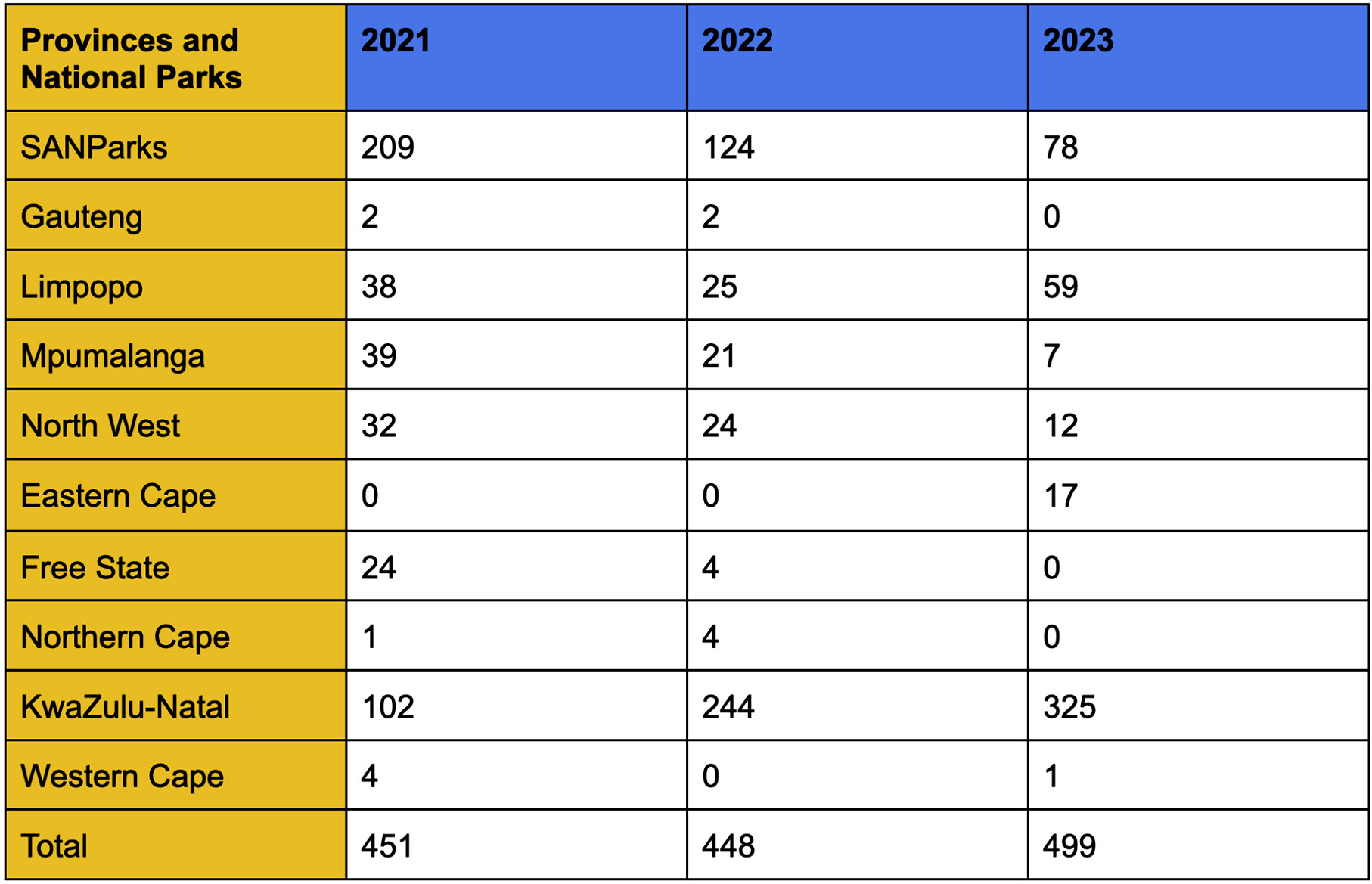WILDLIFE MASSACRE
Local business forums squabble over fencing contracts while KZN faces rhino bloodbath

The poaching of KwaZulu-Natal’s rhino population has reached its worst levels yet, with the province accounting for 65% of all rhinos killed nationwide in 2023.
It has emerged that while poachers were busy plundering one of the country’s biggest state-owned rhino reserves, local “business forums” were squabbling with provincial conservation authorities, demanding a sizeable chunk of a government contract to repair the dilapidated boundary fences of the flagship Hluhluwe-iMfolozi Park.
Across the country, 499 rhinos were poached and dehorned last year. Of this total, 325 were killed in KwaZulu-Natal (with 307 of them killed in Hluhluwe-iMfolozi Park alone), Environment Minister Barbara Creecy said at a media briefing in the village of St Lucia on 27 February.
The current poaching levels in the province are now more than triple that of 2020, when 93 rhinos were slaughtered.

The table gives the provincial and national breakdown for rhino poaching in 2023 compared with 2021 and 2022. (Image: Supplied)
The killing of 325 rhinos in KZN last year also dwarfed casualties for Kruger National Park, where 78 rhinos were shot last year. Kruger is roughly 20 times larger than the 97,000-hectare Hluhluwe-iMfolozi Park.
Creecy announced plans in May last year to provide more than R40-million to repair Hluhluwe-iMfolozi’s increasingly porous fence line. She acknowledged that progress on this project had been “slow”.
According to Sihle Mkhize, the chief executive of Ezemvelo KZN Wildlife, there had been a number of delays in repairing damaged sections of the reserve’s boundary fence.
Mkhize said Ezemvelo was on the point of rolling out the project last year when conservation officials were “confronted” by several local business forums which demanded a 30% cut of the fencing contract.
“They were trying to force us… to get that funding.”
Read more in Daily Maverick: Two out of three SA white rhinos now in private hands while poachers decimate KZN herds

Some of the rhinos found massacred on 8 December 2021, at Inverdoorn Private Game Reserve, just outside Cape Town. (Photo: Inverdoorn Private Game Reserve)
However, said Mkhize, following the intervention of local chiefs in the area, Ezemvelo had been able to “resolve all the challenges”.
He did not explicitly say whether Ezemvelo had agreed to provide any funds to the business forums, but said chiefs and community members had made it clear that “they are not going to allow anyone to just demand things and stop implementation of the project”.
After these issues were resolved towards the end of last year, there were further delays due to the large number of local residents wanting to work on the fencing project.
It now appears that Ezemvelo managed to repair less than 11km of fencing last year, with well over 40km still to go.
However, fencing-related delays aside, it remains clear that there are several other factors behind Ezemvelo losing the war against gangs of armed poachers who are killing the province’s rhinos at a rate of almost one a day.
Mkhize said several new interventions were under way. This included the appointment of a new rhino security manager for Ezemvelo with effect from 1 April.
In response to a request from Daily Maverick to disclose his name and details of his experience in rhino security, Ezemvelo said his identity and credentials would be posted on Ezemvelo’s website only once he was formally presented to the board of Ezemvelo KZN Wildlife at a meeting on Wednesday.
Ezemvelo did say, however, that the new manager held a postgraduate environmental degree, had worked “in the law-enforcement space” and had experience in anti-poaching operations in Hluhluwe-iMfolozi Park, Mkuze Game Reserve and reserves in the Eastern Cape.
Ezemvelo was confident that the new manager was suitably qualified and experienced to perform the job.
A further weakness in park security was the shortage of field rangers.
Last year, the park had a complement of only 55 field rangers, but this number had been increased to 88 and the vacancy rate was now below 10%.
Last year, Ezemvelo anti-poaching units lacked night vision capability for the helicopter team.
“We have closed that gap,” said Mkhize, adding that the conservation agency was strengthening its integrity-testing procedures for frontline rhino anti-poaching staff, including polygraph testing.

Foresty, Fisheries and Environment Minister Barbara Creecy. (Photo: Felix Dlangamandla)
In her feedback report, Creecy said 45 people had been convicted nationally for rhino poaching or trafficking last year – with a conviction rate of 97%.
Arrests included that of a former field ranger who shot and killed a rhino with his R1 rifle in Kruger National Park and failed to report the incident.
“He initially denied that he had discharged his firearm and replaced the ammunition with non-issued ammunition, but ballistic evidence linked his issued firearm to the crime scene.”
During the trial, he claimed that the rhino had charged him. This was rejected by the court and he was convicted and sentenced to 10 years in jail.
In KZN, five people were convicted for killing a rhino, among related offences, and each sentenced to 10 years’ imprisonment.
In Gauteng, an accused was convicted for the possession of two rhino horns found inside a bag in the vehicle in which he was travelling and was sentenced to five years in jail.
The table below gives the provincial and national breakdown for rhino poaching in 2023 compared with 2021 and 2022.
While the rhino population in this park has been progressively decimated over the past 15 years, Creecy attributed the reduction to “strong collaboration between external stakeholders permanently based in KNP” and attending to various wildlife crime cases such as the Skukuza Stock Theft and Endangered Species Unit, Skukuza SAPS and SAPS forensic teams.
There had also been an extensive and ongoing dehorning programme in core areas of Kruger.
Other successful strategies included improved access control, the installation of automated number plate recognition cameras and gate cameras, along with radar detection systems that remotely track any illegal entry by poachers on foot into the KNP.
Significantly, neither Creecy nor Mkhize responded to questions yesterday on whether Ezemvelo is planning to dehorn rhinos in Hluhluwe-iMfolozi Park – one of the last major South African parks where rhinos are not currently dehorned in an effort to deter poachers.

The carcass of a poached rhino in the Kruger National Park on 8 November 2014. (Photo: Gallo Images / Sunday Times / James Oatway)
Commenting on the latest poaching statistics, the conservation group WWF said the high level of poaching in KZN was a “grave concern”.
To assist Ezemvelo KZN Wildlife interventions, WWF had offered to provide support to improve field ranger capacity through targeted training and improving living conditions for rangers.
The organisation was also assisting Ezemvelo to develop an integrity management plan “to build organisational resilience”.
Jeff Cooke, WWF’s Black Rhino Range Expansion project leader, commented: “The province of KwaZulu-Natal has a proud record of having played a critical role in rhino conservation in South Africa when rhino numbers had dwindled to just a few hundred animals (in the late 1950s).”
In September last year, the International Union for Conservation of Nature (IUCN) indicated that rhino numbers across Africa had increased by 5.2% between 2021 and 2022.
Black rhino numbers rose by 4.2% from 2021 to 6,487 animals. White rhino numbers increased to 16,803 (an increase of 5.6%) for the first time since 2012.
“While these updated IUCN population figures provide hope, these gains remain tenuous as long as the poaching crisis continues,” Cooke said. DM






















 Become an Insider
Become an Insider
A fence is not going to keep the Rhino poachers out!
As has been said so many times before, this is a direct result of the ban on the trade of Rhino products. The legitimate (farmed) source was made illegal, the demand does not wain it creates the escalation in illegal means to satisfy it. This has been proven over and over and over again.